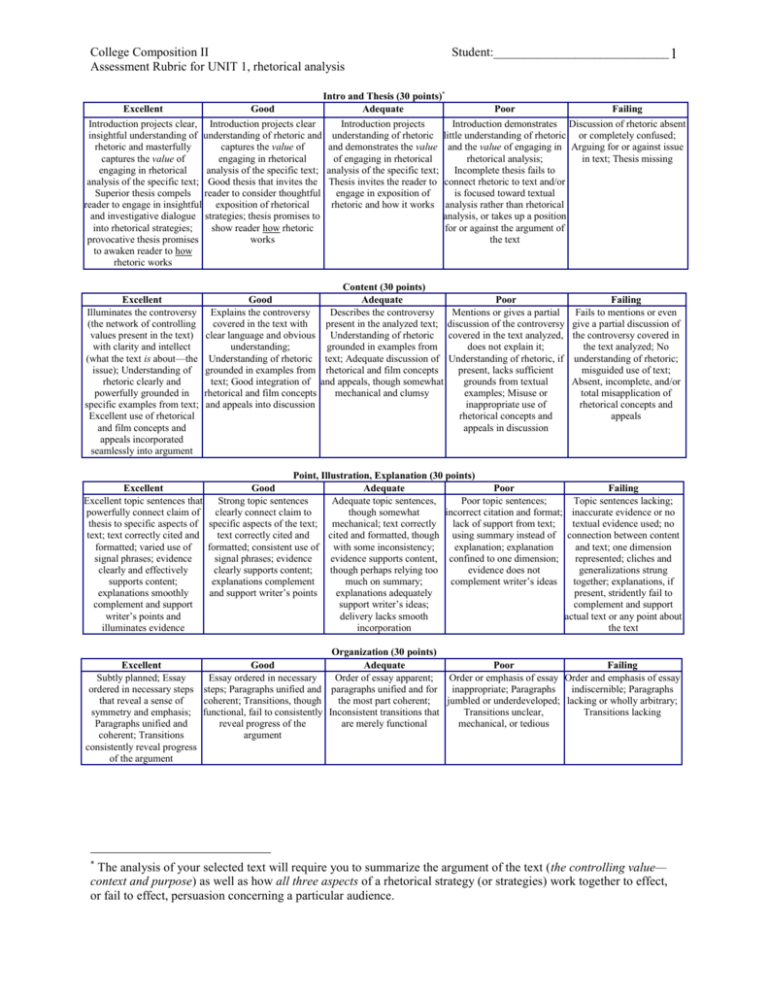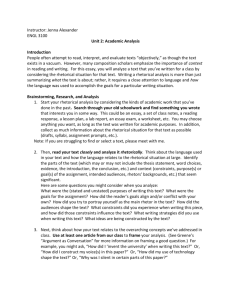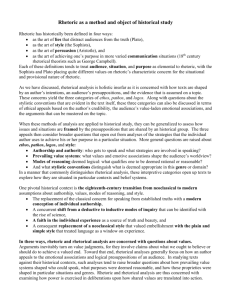English 102--Juergensmeyer--Assessment Rubric Student:
advertisement

College Composition II Assessment Rubric for UNIT 1, rhetorical analysis Excellent Good Introduction projects clear, Introduction projects clear insightful understanding of understanding of rhetoric and rhetoric and masterfully captures the value of captures the value of engaging in rhetorical engaging in rhetorical analysis of the specific text; analysis of the specific text; Good thesis that invites the Superior thesis compels reader to consider thoughtful reader to engage in insightful exposition of rhetorical and investigative dialogue strategies; thesis promises to into rhetorical strategies; show reader how rhetoric provocative thesis promises works to awaken reader to how rhetoric works Excellent Illuminates the controversy (the network of controlling values present in the text) with clarity and intellect (what the text is about—the issue); Understanding of rhetoric clearly and powerfully grounded in specific examples from text; Excellent use of rhetorical and film concepts and appeals incorporated seamlessly into argument Excellent Excellent topic sentences that powerfully connect claim of thesis to specific aspects of text; text correctly cited and formatted; varied use of signal phrases; evidence clearly and effectively supports content; explanations smoothly complement and support writer’s points and illuminates evidence Good Explains the controversy covered in the text with clear language and obvious understanding; Understanding of rhetoric grounded in examples from text; Good integration of rhetorical and film concepts and appeals into discussion Student:____________________________ 1 Intro and Thesis (30 points)* Adequate Poor Failing Introduction projects Introduction demonstrates Discussion of rhetoric absent understanding of rhetoric little understanding of rhetoric or completely confused; and demonstrates the value and the value of engaging in Arguing for or against issue of engaging in rhetorical rhetorical analysis; in text; Thesis missing analysis of the specific text; Incomplete thesis fails to Thesis invites the reader to connect rhetoric to text and/or engage in exposition of is focused toward textual rhetoric and how it works analysis rather than rhetorical analysis, or takes up a position for or against the argument of the text Content (30 points) Adequate Describes the controversy present in the analyzed text; Understanding of rhetoric grounded in examples from text; Adequate discussion of rhetorical and film concepts and appeals, though somewhat mechanical and clumsy Poor Mentions or gives a partial discussion of the controversy covered in the text analyzed, does not explain it; Understanding of rhetoric, if present, lacks sufficient grounds from textual examples; Misuse or inappropriate use of rhetorical concepts and appeals in discussion Failing Fails to mentions or even give a partial discussion of the controversy covered in the text analyzed; No understanding of rhetoric; misguided use of text; Absent, incomplete, and/or total misapplication of rhetorical concepts and appeals Point, Illustration, Explanation (30 points) Good Adequate Poor Failing Strong topic sentences Adequate topic sentences, Poor topic sentences; Topic sentences lacking; clearly connect claim to though somewhat incorrect citation and format; inaccurate evidence or no specific aspects of the text; mechanical; text correctly lack of support from text; textual evidence used; no text correctly cited and cited and formatted, though using summary instead of connection between content formatted; consistent use of with some inconsistency; explanation; explanation and text; one dimension signal phrases; evidence evidence supports content, confined to one dimension; represented; cliches and clearly supports content; though perhaps relying too evidence does not generalizations strung explanations complement much on summary; complement writer’s ideas together; explanations, if and support writer’s points explanations adequately present, stridently fail to support writer’s ideas; complement and support delivery lacks smooth actual text or any point about incorporation the text Organization (30 points) Excellent Good Adequate Poor Failing Subtly planned; Essay Essay ordered in necessary Order of essay apparent; Order or emphasis of essay Order and emphasis of essay ordered in necessary steps steps; Paragraphs unified and paragraphs unified and for inappropriate; Paragraphs indiscernible; Paragraphs that reveal a sense of coherent; Transitions, though the most part coherent; jumbled or underdeveloped; lacking or wholly arbitrary; symmetry and emphasis; functional, fail to consistently Inconsistent transitions that Transitions unclear, Transitions lacking Paragraphs unified and reveal progress of the are merely functional mechanical, or tedious coherent; Transitions argument consistently reveal progress of the argument * The analysis of your selected text will require you to summarize the argument of the text (the controlling value— context and purpose) as well as how all three aspects of a rhetorical strategy (or strategies) work together to effect, or fail to effect, persuasion concerning a particular audience. College Composition II Assessment Rubric for UNIT 1, rhetorical analysis Excellent Sentences that are varied and forceful; diction that is fresh, precise, and idiomatic; Tone that complements the subject, distinguishes the writer, and defines the audience Student:____________________________ 2 Expression and Clarity (20 points) Good Adequate Poor Failing Sentences that are correct Sentences that are correct for Sentences that lack Sentences that are and varied; diction that is the most part, but ordinary; necessary subordination, are incoherent; diction that is clear and idiomatic; Tone Diction that is generally tedious patterns, or nonstandard; Tone that fits the subject, persona, correct and idiomatic; Tone immature; Diction that is indiscernible and audience that is acceptable for the vague or unidiomatic; tone subject inconsistent or inappropriate for audience; Paper written for instructor as audience Effort (40 points)† Excellent Good Adequate Revision process indicates Revision process indicates Revision process indicates clear development; significant development; development; participation in supportive participation in effective participation in peer work-shopping; all essay peer work-shopping; all peer work-shopping; all requirements met; essay requirements essay requirements met; full participation in all aspects of successfully met with participation in all aspects of process excellence apparent; full process participation in all aspects of process and clear benefit for other students during process Excellent In accord with standard usage and MLA format Total: † Poor Failing Little development evident; Revision process not partial participation in peer followed; peer workwork-shopping; Some essay shopping incomplete; essay requirements met; requirements not met; all participation in some aspects aspects of process not of process participated in Usage, Mechanics, and MLA format (20 points)‡ Good Adequate Poor Failing No serious deviations from Few deviations from standard Difficulty with fragments, Serious problems with standard usage and MLA usage, word choice, run-on sentences, comma fragments, run-on sentences, format punctuation, spelling, and splices, agreement, or other comma splices, agreement, or MLA format distracting features in usage, other distracting features in word choice, punctuation, usage, word choice, spelling, and MLA format punctuation, spelling and MLA format (or the lack thereof) /200 Effort is a measure of your demonstration of having developed the draft through having responded to written and verbal comments from me and from your peers. Perhaps more importantly, your development of the draft is a reflection of the written and verbal comments you have given to your peers. Participation in the process requires you to be present in class for workshops and that you have provided apt commentary on your peers’ work. ‡ You must include a Works Cited at the end of the paper in order to cite the work analyzed in your paper. You do not need a separate sheet of paper to do so; simply place it at the very end of your paper. See A Short Guide to Writing About Film.









